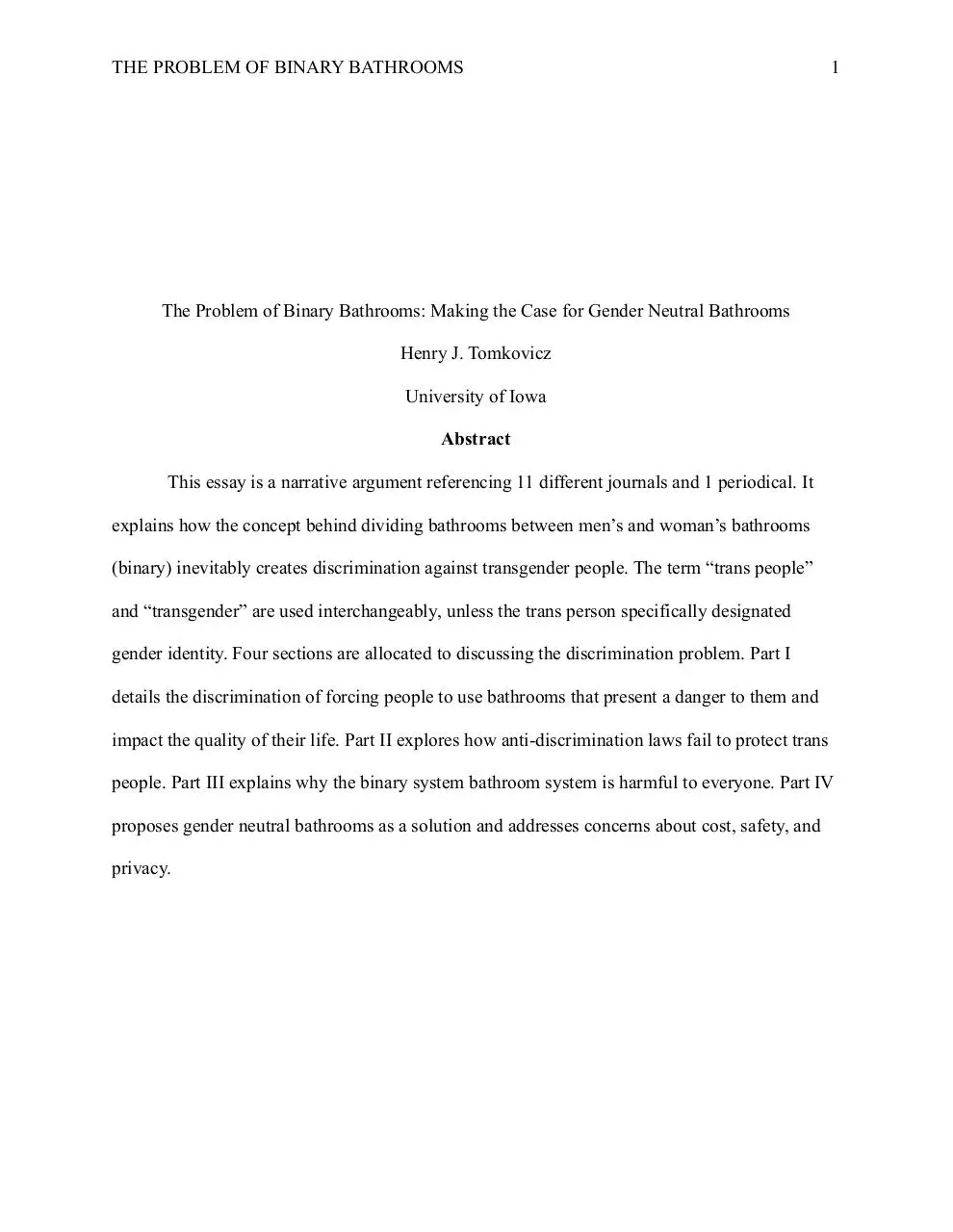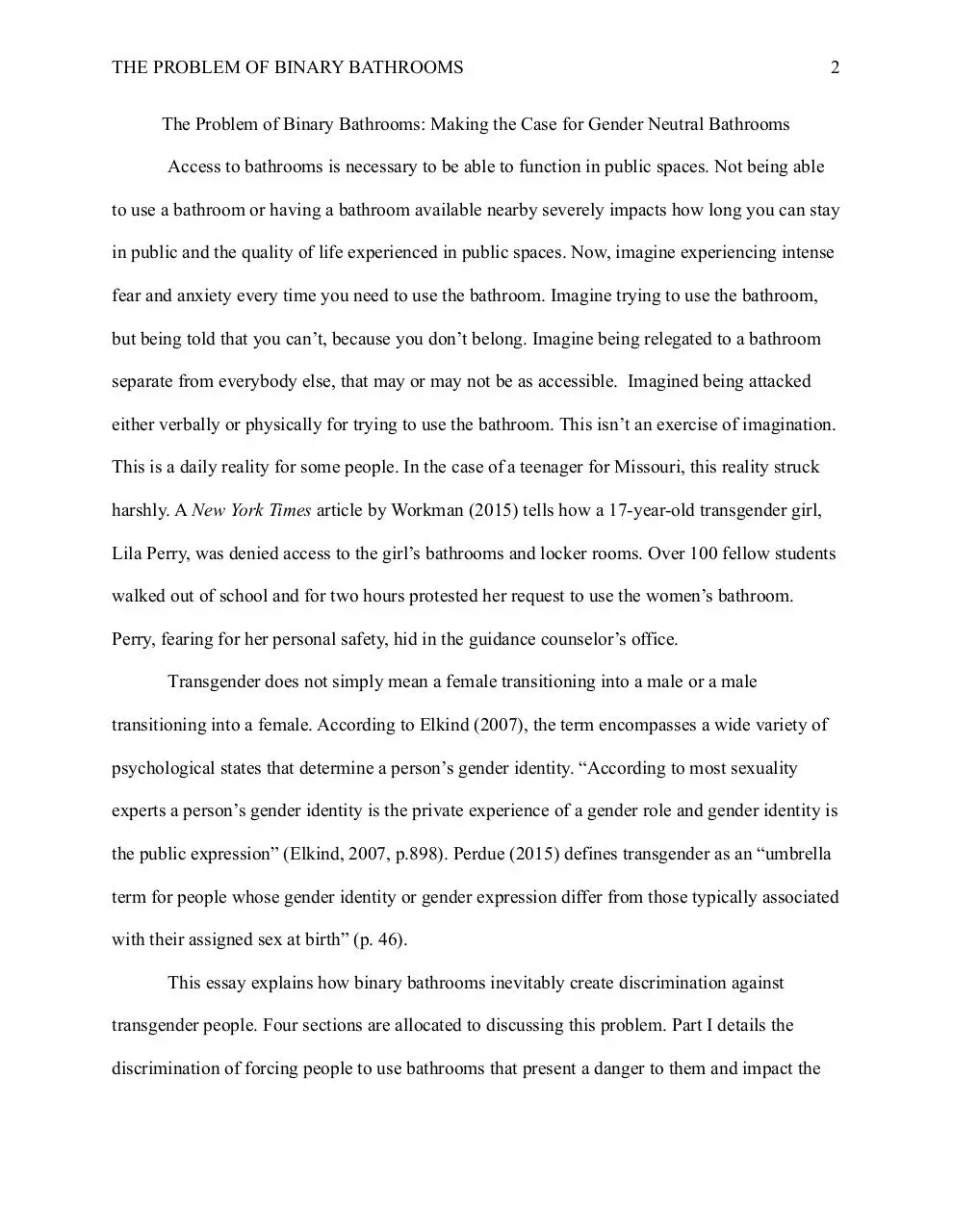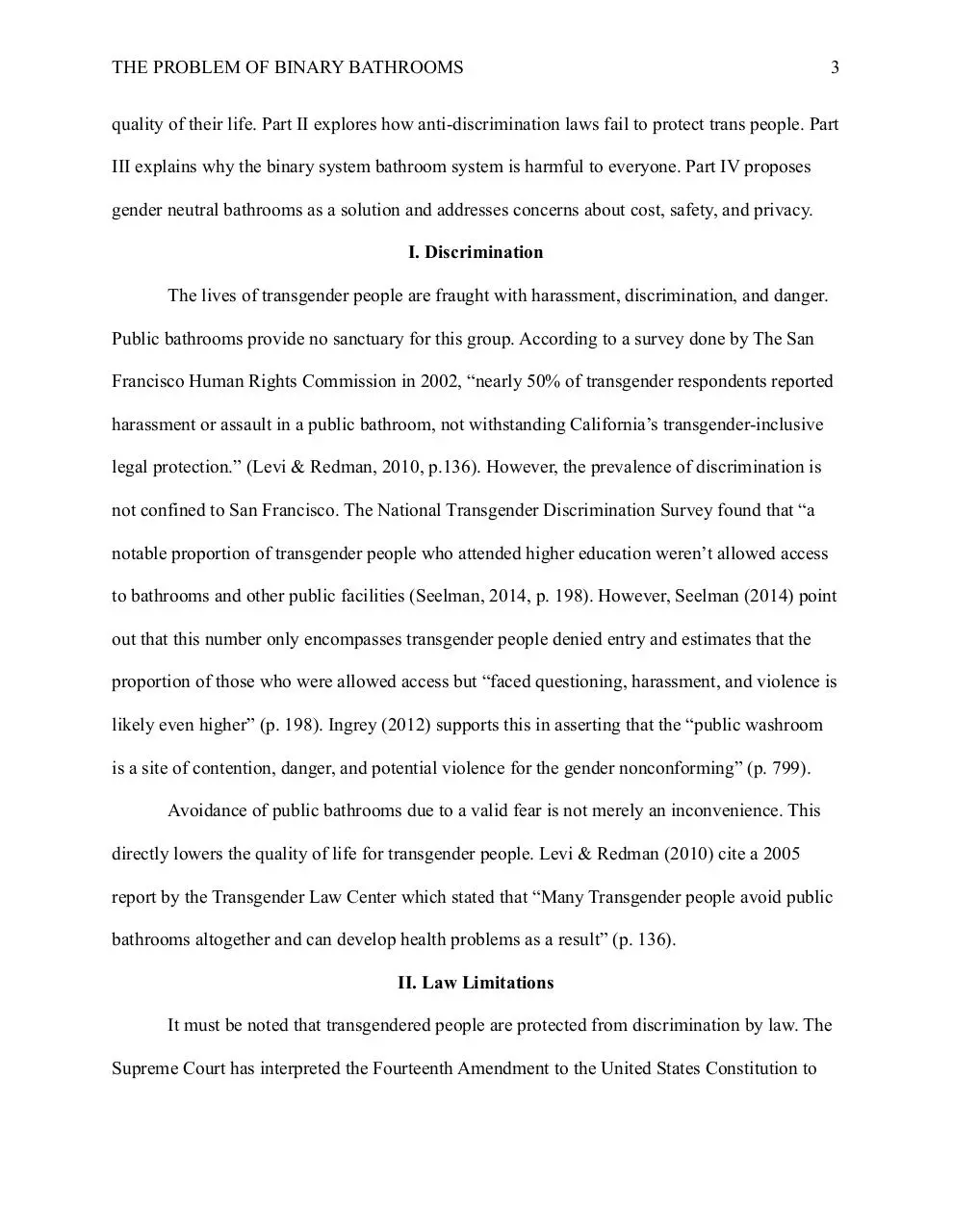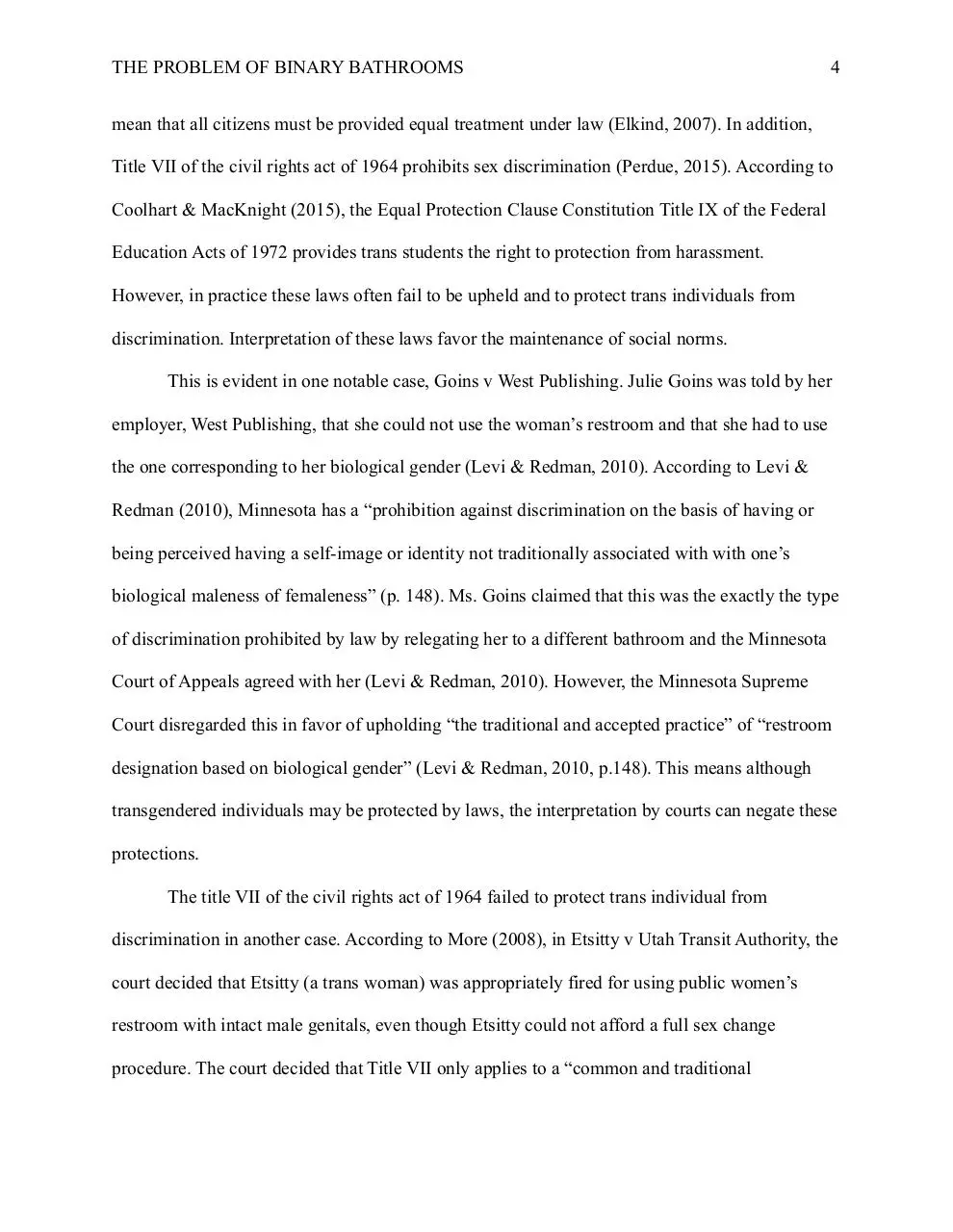FinalDraftBinaryBathroomsTomkovicz (PDF)
File information
Title: Microsoft Word - FinalDraftBinaryBathroomsTomkovicz.docx
This PDF 1.3 document has been generated by Word / Mac OS X 10.10.5 Quartz PDFContext, and has been sent on pdf-archive.com on 13/11/2015 at 02:44, from IP address 173.28.x.x.
The current document download page has been viewed 581 times.
File size: 126.11 KB (11 pages).
Privacy: public file





File preview
THE PROBLEM OF BINARY BATHROOMS
1
The Problem of Binary Bathrooms: Making the Case for Gender Neutral Bathrooms
Henry J. Tomkovicz
University of Iowa
Abstract
This essay is a narrative argument referencing 11 different journals and 1 periodical. It
explains how the concept behind dividing bathrooms between men’s and woman’s bathrooms
(binary) inevitably creates discrimination against transgender people. The term “trans people”
and “transgender” are used interchangeably, unless the trans person specifically designated
gender identity. Four sections are allocated to discussing the discrimination problem. Part I
details the discrimination of forcing people to use bathrooms that present a danger to them and
impact the quality of their life. Part II explores how anti-discrimination laws fail to protect trans
people. Part III explains why the binary system bathroom system is harmful to everyone. Part IV
proposes gender neutral bathrooms as a solution and addresses concerns about cost, safety, and
privacy.
THE PROBLEM OF BINARY BATHROOMS
2
The Problem of Binary Bathrooms: Making the Case for Gender Neutral Bathrooms
Access to bathrooms is necessary to be able to function in public spaces. Not being able
to use a bathroom or having a bathroom available nearby severely impacts how long you can stay
in public and the quality of life experienced in public spaces. Now, imagine experiencing intense
fear and anxiety every time you need to use the bathroom. Imagine trying to use the bathroom,
but being told that you can’t, because you don’t belong. Imagine being relegated to a bathroom
separate from everybody else, that may or may not be as accessible. Imagined being attacked
either verbally or physically for trying to use the bathroom. This isn’t an exercise of imagination.
This is a daily reality for some people. In the case of a teenager for Missouri, this reality struck
harshly. A New York Times article by Workman (2015) tells how a 17-year-old transgender girl,
Lila Perry, was denied access to the girl’s bathrooms and locker rooms. Over 100 fellow students
walked out of school and for two hours protested her request to use the women’s bathroom.
Perry, fearing for her personal safety, hid in the guidance counselor’s office.
Transgender does not simply mean a female transitioning into a male or a male
transitioning into a female. According to Elkind (2007), the term encompasses a wide variety of
psychological states that determine a person’s gender identity. “According to most sexuality
experts a person’s gender identity is the private experience of a gender role and gender identity is
the public expression” (Elkind, 2007, p.898). Perdue (2015) defines transgender as an “umbrella
term for people whose gender identity or gender expression differ from those typically associated
with their assigned sex at birth” (p. 46).
This essay explains how binary bathrooms inevitably create discrimination against
transgender people. Four sections are allocated to discussing this problem. Part I details the
discrimination of forcing people to use bathrooms that present a danger to them and impact the
THE PROBLEM OF BINARY BATHROOMS
3
quality of their life. Part II explores how anti-discrimination laws fail to protect trans people. Part
III explains why the binary system bathroom system is harmful to everyone. Part IV proposes
gender neutral bathrooms as a solution and addresses concerns about cost, safety, and privacy.
I. Discrimination
The lives of transgender people are fraught with harassment, discrimination, and danger.
Public bathrooms provide no sanctuary for this group. According to a survey done by The San
Francisco Human Rights Commission in 2002, “nearly 50% of transgender respondents reported
harassment or assault in a public bathroom, not withstanding California’s transgender-inclusive
legal protection.” (Levi & Redman, 2010, p.136). However, the prevalence of discrimination is
not confined to San Francisco. The National Transgender Discrimination Survey found that “a
notable proportion of transgender people who attended higher education weren’t allowed access
to bathrooms and other public facilities (Seelman, 2014, p. 198). However, Seelman (2014) point
out that this number only encompasses transgender people denied entry and estimates that the
proportion of those who were allowed access but “faced questioning, harassment, and violence is
likely even higher” (p. 198). Ingrey (2012) supports this in asserting that the “public washroom
is a site of contention, danger, and potential violence for the gender nonconforming” (p. 799).
Avoidance of public bathrooms due to a valid fear is not merely an inconvenience. This
directly lowers the quality of life for transgender people. Levi & Redman (2010) cite a 2005
report by the Transgender Law Center which stated that “Many Transgender people avoid public
bathrooms altogether and can develop health problems as a result” (p. 136).
II. Law Limitations
It must be noted that transgendered people are protected from discrimination by law. The
Supreme Court has interpreted the Fourteenth Amendment to the United States Constitution to
THE PROBLEM OF BINARY BATHROOMS
4
mean that all citizens must be provided equal treatment under law (Elkind, 2007). In addition,
Title VII of the civil rights act of 1964 prohibits sex discrimination (Perdue, 2015). According to
Coolhart & MacKnight (2015), the Equal Protection Clause Constitution Title IX of the Federal
Education Acts of 1972 provides trans students the right to protection from harassment.
However, in practice these laws often fail to be upheld and to protect trans individuals from
discrimination. Interpretation of these laws favor the maintenance of social norms.
This is evident in one notable case, Goins v West Publishing. Julie Goins was told by her
employer, West Publishing, that she could not use the woman’s restroom and that she had to use
the one corresponding to her biological gender (Levi & Redman, 2010). According to Levi &
Redman (2010), Minnesota has a “prohibition against discrimination on the basis of having or
being perceived having a self-image or identity not traditionally associated with with one’s
biological maleness of femaleness” (p. 148). Ms. Goins claimed that this was the exactly the type
of discrimination prohibited by law by relegating her to a different bathroom and the Minnesota
Court of Appeals agreed with her (Levi & Redman, 2010). However, the Minnesota Supreme
Court disregarded this in favor of upholding “the traditional and accepted practice” of “restroom
designation based on biological gender” (Levi & Redman, 2010, p.148). This means although
transgendered individuals may be protected by laws, the interpretation by courts can negate these
protections.
The title VII of the civil rights act of 1964 failed to protect trans individual from
discrimination in another case. According to More (2008), in Etsitty v Utah Transit Authority, the
court decided that Etsitty (a trans woman) was appropriately fired for using public women’s
restroom with intact male genitals, even though Etsitty could not afford a full sex change
procedure. The court decided that Title VII only applies to a “common and traditional
THE PROBLEM OF BINARY BATHROOMS
5
interpretation” of sex (More, 2008, p. 307). The court decided that sex is strictly defined by
genitals (More, 2008). The courts decision upheld discrimination by expecting a person to
behave and act a certain way because of their genitals. This is another example of where the
interpretation of law favors traditional concepts of normality over the rights of trans people.
III. Binary System
Bathroom division by biological sex represents a false dichotomy of presenting mutually
exclusive gender choices. It “serves to to reinforce existing sex stereotypes and ideas of
difference” and “on a daily basis people, including transgender people, who do not fit into clear
gender boxes are pressured to conform to sex stereotypes.” (Archibald, 2014, p. 66).
These stereotypes serve as markers to help people with the impossible task of
determining what sex organs a person has by looking at them. According to Ronner (2013), the
inability to assign sex to a person is unsettling to many” (p. 861). This need to define others to
satisfy personal comfort is evident by the reinforcing of sex division and stereotypes associated
with them. The Transgender Law Center surveyed San Francisco in 2001 and found that “butch
women and femme men are frequently subjected to the same types of harassment and
discrimination as transgender people” (Levi & Redman, 2010, p. 166). “On a daily basis people
must clearly show which sex they are, so that others know which bathroom the person belongs
in” (Archibald, 2014, p. 66). According to Browne (2004), “individuals are challenged in toilet
spaces and and their gender questioned”. Rather than an actual method to confirm biological
sexual identity all entrants to bathrooms, its through the expression of stereotypical visual cues
that allow an individual access to one bathroom or the other. According to Ingrey (2012) the
doors of public washrooms (bathrooms) themselves are identification tests for gender identity.
The images associated with bathroom signs support this. The universal women’s bathroom sign
THE PROBLEM OF BINARY BATHROOMS
6
generally includes a stick figure wearing a dress to represent a woman’s bathroom and the image
of a plain stick figure (presumably wearing pants and a shirt) represents the men’s bathrooms.
This implies a dress code. In this dress code lies the foundation for stereotypes about each
gender.
The binary division is unnatural and according to Ingrey (2012), leaves no physical or
conceptual space for people who don’t fit stereotypical gender norms. The binary system is
unnatural, because scholars such as “Julie Greenberg have pointed out that such a binary sex
paradigm does not reflect reality, sex is a spectrum, and the brain may have a male or female
brain predisposition (Ronner 2013, p.863-864). Stereotypes about each division of the binary
system are particularly harmful to this wide array of people who don’t fit in. Furthermore, these
binary bathroom images are harmful in that they confuse male and female biological sex with
gender. More (2015) in summary, supports this notion and further asserts that these images
confirm harmful stereotypes about gender and biological sex.
IV. Gender Neutral Bathrooms
Gender Neutral Bathrooms, bathrooms that allow everyone, would solve discrimination
and harm caused by binary bathrooms. Gender neutral bathrooms are an excellent way to preemptively ensure that everyone, including transgendered people, have access to a safe means of
using the bathroom (Perdue, 2015).
One objection to the institution of these bathrooms is cost but, the cost of wouldn’t
necessarily be too great. In many cases there won’t even be a need for renovation. Archibald
(2014) suggest that stalls currently exist in both men’s and women s restrooms for both sexes to
use and that the only change necessary would be the installation of a more appropriate gender
neutral bathroom sign. A picture of a seated toilet would serve well in this capacity. Purdue
THE PROBLEM OF BINARY BATHROOMS
7
(2015) states that such actions may prevent costly litigation for all involved, when the the law is
currently and in the future will be, in contention.
Another concern to address with the institution of gender neutral bathrooms is safety.
Jeffreys (2014) supports the binary division of bathrooms, because women need protection from
men. There is “plentiful evident that women and girls do face considerable danger from malebodied persons who entered a sex segregated toilet” (Jeffreys, p. 48). However, this is a gross
mischaracterization of transgender people, particularly transgender women.
The idea that transgender people’ s access to bathrooms presents a danger to women and
girls in the same room is unfounded for the following reasons. Firstly, “there is no evidence to
support that transgender individuals are more likely to be sexual predators than the general
population, and such criminal activity can be accomplished without permissive bathroom-access
laws.” (Elkind, 2007, p.924). Therefore, an entire group of innocent people (transgender people)
are being punished or discriminated against to prevent a separate group (predatory men) from
committing a crime with no association to the innocent group. If laws need to be passed to help
prevent criminals and sexual predators from accessing bathrooms, then specific laws tailored to
this effect would be more appropriate. Levi and Redman (2010) point out that “Even, In San
Francisco (the U.S city most likely with the highest percentage of transgender women per capita)
there has never been a single police report of a transgender woman harassing another woman in
the bathroom” (p. 160).
According to Jeffreys (2014), “research suggests that bystanders very rarely intervene in
instances of sexual harassment and assault. (p. 48) Taking into account that Elkin (2007) said
that “criminal activity can be accomplished without bathroom access laws” (p.924). Both
authors are actually in agreement that there is a mutually inclusive safety problem in segregating
THE PROBLEM OF BINARY BATHROOMS
8
bathrooms by sex. Jeffreys (2014) completely dismisses the idea that other presences may deter
or regulate the behavior of potential security or safety risks. However, the idea of hiring security
specifically trained to prevent and intervene in instances of sexual assault would address safety
concerns raised by Jeffreys (2014). Also, figuring a way to put types of panic buttons or send
distress calls in bathrooms would benefit everyone who believes their health and safety is at risk.
Conclusion
Public bathrooms are not private spaces. Purdue (2015), in conclusion, recommends
gender neutral restrooms as a proactive and accommodating approach. Jeffrey’s (2014) suggests
that bathrooms are completely individualized in a way that would offer dignity safety and respect
to all users and wouldn’t need to be labeled as anything other than bathroom (p.49) Purdue
(2015) also recommends the use gender neutral restrooms. Shared mirror and sink space would
prevent transgendered people from being singled out and relegated to bathrooms that may not be
as accessible. This shared space would be uncomfortable at first but would safer for all because it
would eventually remove the stereotypes that we use to define gender. Work by Levi & Redman
(2010), serves as reminder that “butch women and femme men are frequently subjected to the
same types of harassment and discrimination as transgender people” (p. 166).
THE PROBLEM OF BINARY BATHROOMS
9
References
Archibald, C. J. (2014). Transgender student in Maine may use bathroom that matches gender
identity- Are co-ed bathrooms next? UMCK Law Review 83(1), 57-71
Browne, K. (2004). Genderism and the bathroom problem: (re)materialising sexed sites,
(re)creating sexed bodies. Gender, Place & Culture A Journal of Feminist Geography.
11(3), 331-346, DOI: 10.1080/0966369042000258668
Coolhart, D., Macknight, V. (2015). Working with transgender youths and their families:
counselors and therapists as advocates for trans-affirmative school environments, Journal
of Counselor Leadership and Advocacy, 2(1), 51-64 DOI:
10.1080/2326716X.2014.981767
Elkind, D. (2007). The constitutional implications of bathroom access based on gender identity:
an examination of recent developments paving the way for the next frontier of equal
protection. Journal of Constitutional Law, 9(3), 895-928
Ingrey, J. C. (2012). The public school washroom as analytic space for troubling gender:
investigating the spatiality of gender through students’ self-knowledge. Journal of
Gender and Education 24(7), 799–817
Jeffreys, S. (2014). The politics of the toilet: a feminist response to the campaign to ‘degender’ a
women's space. Women Studies International Forum, 45, 42-51
Levi, J. & Redman, D. (2010). The cross-dressing case for bathroom equality. Seattle University
Law Review, 34, 133-171
More, A. (2008). Coming out of the water closet: The case against sex segregated bathrooms.
Texas Journal of Women and the Law, 17, 297-315
Download FinalDraftBinaryBathroomsTomkovicz
FinalDraftBinaryBathroomsTomkovicz.pdf (PDF, 126.11 KB)
Download PDF
Share this file on social networks
Link to this page
Permanent link
Use the permanent link to the download page to share your document on Facebook, Twitter, LinkedIn, or directly with a contact by e-Mail, Messenger, Whatsapp, Line..
Short link
Use the short link to share your document on Twitter or by text message (SMS)
HTML Code
Copy the following HTML code to share your document on a Website or Blog
QR Code to this page

This file has been shared publicly by a user of PDF Archive.
Document ID: 0000314556.